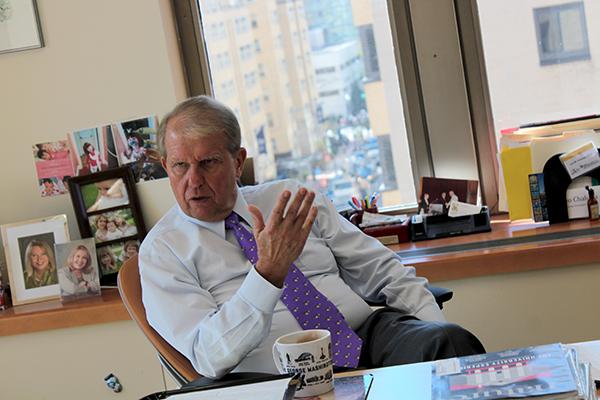GW’s research office has embedded more than a dozen staffers in individual schools to support researchers as the University looks to help faculty bring in more grants.
Staffers have worked more closely with researchers by moving into offices within schools over the past two years, and the University’s top research official said the change is one of more to come that will help his office better support faculty researchers.
“The infrastructure for our faculty, to be quite frank, in the past has been poor,” Vice President for Research Leo Chalupa said. “We’re not there yet. There’s still frustration. It needs to be made better and it’s got to be made better.”
GW is following a model adopted by top research institutes across the country, whose staffs try to take on as many administrative responsibilities as possible so researchers can concentrate on their work. Chalupa said at least 19 members of his staff have moved out of the central research office and into schools.
He said researchers shouldn’t have to deal with administrative duties, which have increased over the past few years as more regulations have passed on the federal level.
“The way we want our faculty to function is they need to just worry about the science and nothing else. They should be thinking about new ideas for grants and writing the grants,” Chalupa said. “All this other sort of administrative stuff like filling out forms, checking the budget, filling out the budget – somebody else should be doing that.”
He added that the size of his staff hasn’t increased during his six-year tenure at GW, but the department’s structure has a direct connection to how well researchers are able to work.
Taylor Maxwell, a researcher in the Computational Biology Institute, said his transition to the University in late 2013 came with some challenges.
“Three of the four different people I worked with left or got moved around,” he said. “Hopefully it will stabilize, but all of my interactions have been pretty good and very helpful.”
Matthew Kay, a professor of electrical and computer engineering, said the amount of research support he receives now compared to when he first came to GW has increased overall.
“Professors were saying, ‘OK, that’s great, we want to do more research and now we’re trying to do it this,’” Kay said. “But we need help. We need better support submitting grants. We need better support administering grants. We need better support on hiring research personnel.”
Kay said even though the staff changes were only made in recent years, the differences were already noticeable.
“Things move slowly in a large organization,” he said. “Sometimes it takes time for people to see big improvements and I think that those improvements are happening here.”
Ramin Sedehi, the head of Berkeley Research Group’s Higher Education Consulting practice, said an increasingly competitive research climate has pushed colleges to hire more research staff focused on helping faculty before the funding has even made its way onto campus.
Staffers shouldn’t be as focused on the actual work behind the research, he said, but they should have the skills that can let researchers succeed and earn grants when it’s nearly impossible to do so.
“A staff member with a scientific background would be very helpful and be able to work those problems a little easier,” he said. “But some universities are actively looking for staff with good language skills, English majors, liberal arts majors. The art of writing these awards is actually far more important than understanding the science of it.”
Katherine Ho, the executive director of the Office of Sponsored Research at Stanford University, said her university was able to earn so many externally funded grants in part because of the strong support system in place for researchers.
Research staff at Stanford aren’t confined to a specific school, she said, but work one-on-one with faculty across the university to become familiar with as many funding processes as possible.
“We have the infrastructure to support all of the research that’s happening here,” she said. “A lot of the time, people at smaller research institutions are always asking, ‘How can we do that?’ Luckily we’re at a place where the institution does that for us.”







